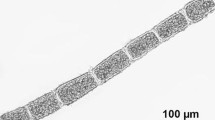Summary
When growing in the sunlight, some specimens of Spongilla lacustris are coloured green due to the presence of symbiotic unicellular chlorellae. The algae live inside most sponge cells. The chlorellae were extracted from green sponges, cultivated, added to algae-free sponges and fixed after different incubation times. In this way the uptake of the algae, their distribution and their final whereabouts in the mesenchymatic cells could be followed by in vivo microscopy, phase-contrast microscopy and electron microscopy. A few minutes after addition, the chlorellae can be found inside the choanocyte chambers. Here they are taken up by the cell bodies and collars of the choanocytes. Pinacocytes are also involved in the uptake. The distribution of algae results from a specific transmission from the donor cell to the receiver cell. The chlorellae are not released from their host vacuoles until they are extensively enclosed by the cell taking them up. Six hours after addition, all sponge cells contain algae except granulocytes, microscleroblasts, the pinacocytes of the peripheral rim region and those of the pinacoderm. The chlorellae are able to divide inside the sponge cells.
Similar content being viewed by others
Abbreviations
- StM :
-
Stereo-microscopical photograph
- PhC :
-
Phase-contrast microscopical photograph
- EM :
-
Electron microscopical photograph
References
Agnes B, Brondsted HV (1953) The effect of symbiotic zoochlorellae on the germination rate of gemmules of Spongilla lacustris (L.). Vidensk Medd Dan Naturhist Foren Khobenhavn 115:133–144
Ankel WE, Eigenbrodt H (1950) Über die Wuchsform von Spongilla in sehr flachen Räumen. Zool Anz 145:195–204
Frost TM (1978) The ecology of the freshwater sponge Spongilla lacustris. Thesis, Dartmough College, Hanover 1–196
Frost TM, Williamson CE (1980) In situ determination of the effect of symbiotic algae on the growth of the freshwater sponge Spongilla lacustris. Ecology 61:1361–1370
Gilbert JJ, Allen HL (1973a) Studies on the physiology of the green freshwater sponge Spongilla lacustris: primary productivity, organic matter, and chlorophyll content. Verh Int Verein Limnol 18:1413–1420
Gilbert JJ, Allen HL (1973b) Chlorophyll and primary productivity of some green, freshwater sponges. Int Rev Ges Hydrobiol 58:633–658
Goetsch W, Scheuring L (1927) Parasitismus und Symbiose der Algengattung Chlorella. Z Morphol Oekol Tiere 7:220–253
Karakashian SJ (1963) Growth of Paramecium bursaria as influenced by the presence of algal symbionts. Physiol Zool 36:52–68
Karakashian SJ, Karakashian MW, Rudzinska MA (1968) Electron microscopic observations on the symbiosis of Paramecium bursaria and its intracellular algae. J Protozool 15:113–128
Langenbruch P-F, Weissenfels N (1987) Canal systems and choanocyte chambers in freshwater sponges (Porifera, Spongillidae). Zoomorphology 107:11–16
Muscatin LM, Karakashian S, Karakashian MW (1967) Soluble extracellular products of algae symbiosis with a ciliate, a sponge, and a mutant hydra. Comp Biochem Physiol 20:1–12
Reynolds ES (1963) The use of lead citrate at high pH as an electron-opaque stain. J Cell Biol 17:208–212
Saller U, Weissenfels N (1985) The development of Spongilla lacustris from the oocyte to the free larva (Porifera, Spongillidae). Zoomorphology 105:367–374
Sarà M, Liaci L (1964) Symbiontic association between zooxanthellae and two marine sponges of the genus Cliona. Nature London 203:321
Sarà M (1971) Ultrastructural aspects of the symbiosis between two species of the genus Aphanocapsa (Cyanophyceae) and Ircinia (Demospongiae). Mar Biol 11:214–221
Vacelet J (1971) Etude en microscopie électronique de l'association entre une cyanophycée chroococcale et une éponge du genre Verongia. J Microsc Oxford 12:363–380
Van de Vyver G, Willenz P (1975) An experimental study of the life-cycle of the fresh-water sponge Ephydatia fluviatilis in its natural surroundings. Wilhelm Roux' Arch Entwicklungsmech Org 177:41–52
Weissenfels N (1974) Bau und Funktion des Süßwasserschwamms Ephydatia fluviatilis. I. Das Nephridialsystem der Pinacocyten. Cytobiology 8:269–288
Weissenfels N (1975) Bau und Funktion des Süßwasserschwamms Ephydatia fluviatilis L. (Porifera). II. Anmerkungen zum Körperbau. Z Morphol Oekol Tiere 81:241–256
Weissenfels N (1977) Bau und Funktion des Süßwasserschwamms Ephydatia fluviatilis L. (Porifera). IV. Die Entwicklung der monaxialen SiO2-Nadeln in Sandwich-Kulturen. Zool Jahrb Abt Anat Ontog Tiere 98:355–371
Willenz P (1980) In: Smith DC, Tiffon Y (eds) Kinetic and morphological aspects of particle ingestion by the freshwater sponge Ephydatia fluviatilis L. Nutrition in the Lower Metazoa. Pergamon Press, Oxford, pp 163–178
Williamson CE (1979) An ultrastructural investigation of algal symbiosis in white and green Spongilla lacustris (L.) (Porifera, Spongillidae). Trans Am Microsc Soc 98:59–77
Author information
Authors and Affiliations
Rights and permissions
About this article
Cite this article
Saller, U. Microscopical aspects on symbiosis of Spongilla lacustris (Porifera, Spongillidae) and green algae. Zoomorphology 108, 291–296 (1989). https://doi.org/10.1007/BF00312161
Received:
Issue Date:
DOI: https://doi.org/10.1007/BF00312161




